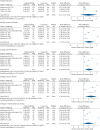Breathing techniques to reduce symptoms in people with serious respiratory illness: a systematic review
- PMID: 39477355
- PMCID: PMC11522968
- DOI: 10.1183/16000617.0012-2024
Breathing techniques to reduce symptoms in people with serious respiratory illness: a systematic review
Abstract
Background: In adults with serious respiratory illness, breathlessness is prevalent and associated with reduced health-related quality of life. The aim of this review was to assess the impact of breathing techniques on breathlessness in adults with serious respiratory illness.
Methods: Electronic databases were searched to identify randomised controlled trials testing breathing techniques (techniques that aim to alter the respiratory pattern, excluding respiratory muscle training) in people with serious respiratory illness. The primary outcome was breathlessness and secondary outcomes were health-related quality of life and adverse events. Two authors independently screened for inclusion, evaluated risk of bias and extracted data.
Results: 73 randomised controlled trials were included with 5479 participants, most with COPD or asthma. Breathing exercises (pursed lip and/or diaphragmatic breathing) reduced breathlessness measured by the modified Medical Research Council scale compared to usual care (mean difference (MD) -0.40 points, 95% CI -0.70- -0.11, eight studies, n=323), although the effect did not exceed the minimal important difference. Yoga breathing also improved modified Medical Research Council score compared to usual care (MD -1.05 points, 95% CI -2.45-0.35, three studies, n=175). Breathing techniques consistently improved health-related quality of life in people with COPD and asthma on multiple health-related quality of life measures in comparison to usual care, with effects that generally exceeded the minimal important difference. No adverse events related to breathing techniques were reported.
Conclusion: Breathing techniques may improve breathlessness, and consistently improve health-related quality of life, in people with serious respiratory illness. These findings support the use of breathing exercises in the care of people with serious respiratory illness.
Copyright ©The authors 2024.
Conflict of interest statement
Conflicts of interest: L. Romero declares funding from the European Respiratory Society to design search strategies for this review. A.E. Holland declares authorship on one of the systematic reviews included in this study but no other conflicts of interest. All other authors declare no conflicts of interest.
Figures





Comment in
-
Evidence-based management of symptoms in serious respiratory illness: what is in our toolbox?Eur Respir Rev. 2024 Oct 30;33(174):240205. doi: 10.1183/16000617.0205-2024. Print 2024 Oct. Eur Respir Rev. 2024. PMID: 39477357 Free PMC article.
References
Publication types
MeSH terms
LinkOut - more resources
Full Text Sources
Medical
